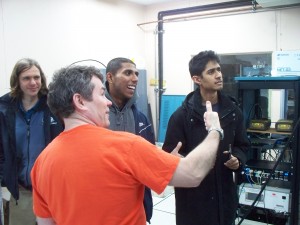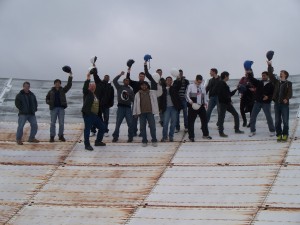05.05
Last week I took my ENG/PHYS 4350 class to ARO for the annual GPS satellite tracking exercise. For the past few years we have been doing a reduced set of tests, but this year, thanks to the efforts of Thoth Technologies and faculty colleague Ben Quine, the station is now fully functional. All student groups showed that they had “the right stuff” as their code was able to predict where selected GPS satellites would be – so they were able to “track” the satellite.
Their code produces a command file which tells the antenna control system azimuth and elevation
positions. We give the command file to the pointing computer and then hook up a spectrum analyzer to see the GPS L-band transmission. If the angles are correct (to within about 40 arcminutes, which is the 3 dB beamwidth of the antenna), then we see the L-band spectrum (the “Thumbs Up” condition).
One of the highlights of the visit is a “dish walk” on the 46-m reflector surface – the class and I posed for a picture. Not sure how many more years we will be doing this because the surface is being painted. Many thanks to Nick Balaskas (and Ben) for taking some excellent “action” shots of the event.
ENG/PHYS 4350 Space Hardware is a 4th year course offered to space engineering, space science and physics students (it is compulsory for space engineers). For more details see my Teaching page.

